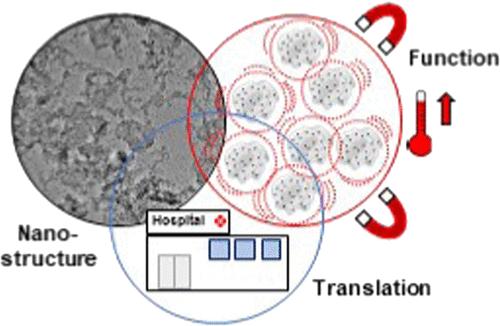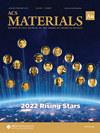Insight into the Internal Structure of High-Performance Multicore Magnetic Nanoparticles Used in Cancer Thermotherapy
IF 5.7
Q2 CHEMISTRY, PHYSICAL
引用次数: 0
Abstract
Multicore magnetic nanoparticles (MNPs), comprising iron oxide cores embedded in a sugar or starch matrix, are a class of nanomaterials with promising magnetic heating properties. Their internal structure, and particularly the strength of the internal core–core magnetic interactions, are believed to determine the functional properties, but there have been few detailed studies on this to date. We report here on an interlaboratory and multimodality transmission electron microscopy (TEM) and magnetic study of a high-performance MNP material (supplied by Resonant Circuits Limited, RCL) that is currently being used in a clinical study for the treatment of pancreatic cancer. TEM data were collected under a variety of conditions: conventional; high-resolution; scanning; cryogenic; and, for the first time, liquid phase. All the imaging modes showed mostly irregular dextran lamellae of lateral dimensions 30–90 nm, plus ca. 15% n/n of what appeared to be 30–60 nm long “nanorods”, and a multitude of well-dispersed ca. 3.7 nm diameter iron oxide cores. Cryogenic electron tomography indicated that the nanorods were edge-on lamellae, but in dried samples, tomography showed rod- or lath-shaped forms, possibly resulting from the collapse of lamellae during drying. High-resolution TEM (HRTEM) showed the dextran to be crystallized in the low-temperature hydrated dextran polymorph. Magnetic remanence Henkel-plot analysis indicated a weak core–core interaction field of ca. 4.8 kA/m. Theoretical estimates using a point-dipole model associated this field with a core-to-core separation distance of ca. 5 nm, which tallies well with the ca. 4–6 nm range of separation distances observed in liquid-cell TEM data. On this basis, we identify the structure–function link in the RCL nanoparticles to be the unusually well-dispersed multicore structure that leads to their strong heating capability. This insight provides an important design characteristic for the future development of bespoke nanomaterials for this significant clinical application.

洞察用于癌症热疗的高性能多核磁性纳米粒子的内部结构
多核磁性纳米粒子(MNPs)由嵌入糖或淀粉基质的氧化铁核组成,是一类具有良好磁加热特性的纳米材料。它们的内部结构,尤其是内部磁芯与磁芯之间磁性相互作用的强度,被认为决定了其功能特性,但迄今为止这方面的详细研究还很少。我们在此报告对高性能 MNP 材料(由 Resonant Circuits Limited, RCL 提供)进行的实验室间多模态透射电子显微镜(TEM)和磁性研究,该材料目前正用于治疗胰腺癌的临床研究。TEM 数据是在各种条件下采集的:传统、高分辨率、扫描、低温,并首次采集了液相数据。所有成像模式都显示出大部分不规则的右旋糖酐片层,横向尺寸为 30-90 纳米,另外还有约 15% n/n 的 30-60 纳米长的 "纳米棒",以及大量分散良好的直径约 3.7 纳米的氧化铁核心。低温电子断层扫描显示,纳米棒为边缘层状,但在干燥的样品中,断层扫描显示为杆状或板条状,可能是干燥过程中层状塌陷造成的。高分辨率 TEM(HRTEM)显示右旋糖酐以低温水合右旋糖酐多晶型态结晶。磁剩磁亨克尔图分析表明,磁芯-磁芯相互作用场很弱,约为 4.8 kA/m。使用点偶极子模型进行的理论估算表明,该磁场与大约 5 nm 的磁芯-磁芯分离距离有关,这与大约 4-6 nm 的分离距离范围相符。4-6 nm 的分离距离范围。在此基础上,我们确定了 RCL 纳米粒子的结构与功能之间的联系,即异常分散的多核结构导致了其强大的加热能力。这一见解为今后开发用于这一重要临床应用的定制纳米材料提供了重要的设计特征。
本文章由计算机程序翻译,如有差异,请以英文原文为准。
求助全文
约1分钟内获得全文
求助全文
来源期刊

ACS Materials Au
材料科学-
CiteScore
5.00
自引率
0.00%
发文量
0
期刊介绍:
ACS Materials Au is an open access journal publishing letters articles reviews and perspectives describing high-quality research at the forefront of fundamental and applied research and at the interface between materials and other disciplines such as chemistry engineering and biology. Papers that showcase multidisciplinary and innovative materials research addressing global challenges are especially welcome. Areas of interest include but are not limited to:Design synthesis characterization and evaluation of forefront and emerging materialsUnderstanding structure property performance relationships and their underlying mechanismsDevelopment of materials for energy environmental biomedical electronic and catalytic applications
 求助内容:
求助内容: 应助结果提醒方式:
应助结果提醒方式:


